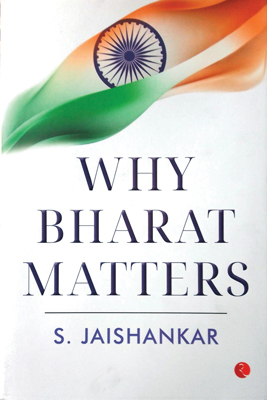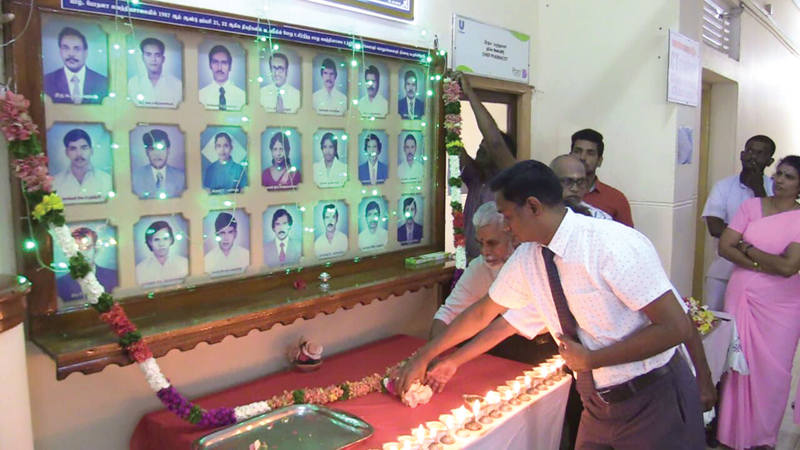A few days ago, Jaffna Teaching Hospital paid tribute to 21 civilians including patients and doctors who were gunned down by the Indian Peace Keeping Force (IPKF) personnel on October 21, 1987.
The portraits of all 21victims were displayed within the Hospital decorated with garlands to mark the 37th anniversary of the horrible incident.
Indian Foreign Minister Subramaniam Jeyshankar, a career diplomat was functioning as a special official handling the political side of the IPKF at the Indian High Commission in Colombo at that time. This followed the decision jointly made by the Indian and the Lankan Governments to deploy the IPKF in the North and the East to ensure the successful implementation of the North and the East Provincial Council system which was brought out following the signing of the Indo-Lanka Accord.

Jaishankar’s book takes a critical
look at the IPKF’s role in Sri Lanka
Foreign Minister S.Jeyshankar from the time he retired from the Indian diplomatic service and entered politics said that the IPKF mission in Sri Lanka was a total failure and a diplomatic blunder which created a messy situation with regard to the close ties between India and Sri Lanka.
Militarily failure
The arrival of the IPKF was not only a diplomatic blunder, it was also a terrible militarily failure for India which identified itself as a regional superpower in South Asia.
High profile diplomats and military experts from India as well as from the international community were closely monitoring India’s decision to send the IPKF to the Northern and the Eastern Provinces of Sri Lanka following the signing of the Indo-Lanka Accord. India got a warning signal when the late Indian Prime Minister, Rajiv Gandhi was attacked by a Naval rating while inspecting the guard of honour on his arrival at President’s House to sign the Indo-Lanka Accord.
The attack on Rajiv Gandhi at the guard of honour accorded to him was a stern warning to India that the IPKF mission was going to be a failure and the incident also clearly indicated that one day the handsome Indian Prime Minister was going to be a prime target of the Liberation Tigers of Tamil Eelam (LTTE).
When the decision was made to send the IPKF to the North and the East, General Krishnaswamy Sundarji was India’s Army Chief. General Sundarji was a Tamil from the State of Tamil Nadu and a veteran military strategist who had even worked out the `Operation Bluestar’ to flush out Sikh militants from the Golden Temple in Amristar in Punjab on June 1984. At that time Gen.Sugarji was one of the adjacent commanders under Indian Army Chief General A.S. Waidya who was later gunned down by a Sikh militant while he was in retirement.
Well-received
Initially the arrival of the IPKF in the North was well received by the people in the North, thinking the peace process initiated by India was going to be a success story. However, the Indian mission failed both militarily as well as politically resulting in the Indian Foreign Minister S.Jeyashankar reiterating that the mission was a total failure whenever he is questioned about diplomatic issues pertaining to Sri Lanka.
Jeyashankar and the Indian military top brass who had served in the IPKF mission pointed out though the decision was made by the Rajiv Gandhi Government in agreement with the Lankan leadership to send the IPKF to Sri Lanka, the ground realities with regard to the North and the East and the strength of the LTTE were poorly underestimated by the Indians.
The memorial event on October 21 to pay tribute to 21 people who lost their lives was a reminder that the IPKF which had launched its first- ever military operation code named `Operation Pawan’ to take control of Jaffna from the grip of the LTTE, were not aware that they had launched the attack on the Jaffna General hospital and the tricky manipulations of the LTTE.
The event held in memory of these 21 victims at the Jaffna Teaching Hospital is an annual event. This time around it was the 37th year with family members of the victims and the Jaffna medical staff paying tribute on October 21.
From the time the Tamil militants became active, the Jaffna Teaching hospital had suffered immensely due to cross fire between the Armed Forces within the Jaffna Fort and the gun toting militants who cared less about the premier commercial buildings or the Jaffna Teaching Hospital.
Jaffna Teaching Hospital
Even before the IPKF shooting incident at the Jaffna Teaching Hospital, Tamil militants standing behind the Hospital premises on Victoria Road, Jaffna fired long range rockets and shells at the Armed Forces from within the Jaffna Fort. The retaliation from the Jaffna Fort was severe. Once a section of the hospital building was badly damaged due to a shell landing on the roof of the building.
In the backdrop of the Jaffna Teaching Hospital tragedy, Indian Foreign Minister S. Jeyashankar who even criticised the UN a few weeks ago for failing to bring an end to the war between Israeli soldiers and Hezbollah militants in Lebanon has very rightly said that India’s IPKF mission was a diplomatic blunder. He has even said so in his latest book titled ‘Why Barat Matters’.
Veteran diplomat Dr.S. Jeyashankar who is now the Indian Foreign Minister describing the IPKF mission in Sri Lanka as being a diplomatic blunder echoes louder than ever as the Jaffna Teaching Hospital marked the 37th anniversary of the tragedy.









